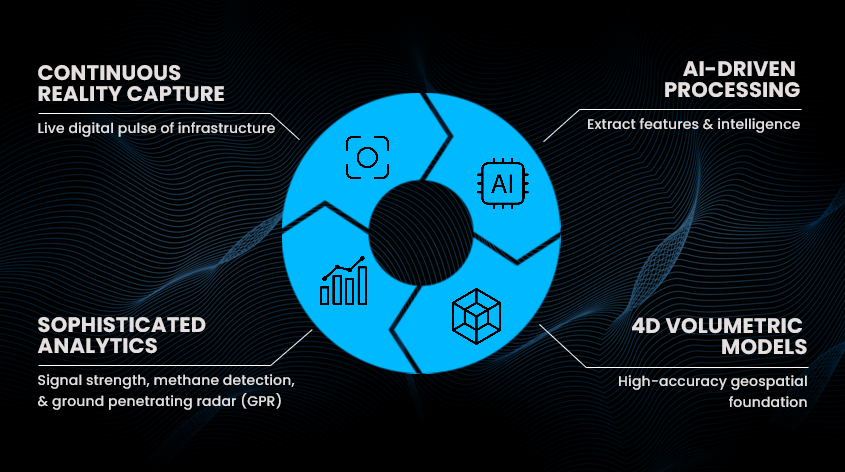At Voxelmaps, we believe the energy industry is on the cusp of a profound transformation. As Brian Soliday, our Chief Revenue Officer, recently highlighted at the Accenture International Utilities and Energy Conference, the future of energy infrastructure management is moving beyond traditional mapping — toward dynamic, AI-powered Spatial Digital Twins.
Why Beyond Traditional Mapping?
The energy sector faces unprecedented challenges:
- The urgent need to decarbonize and integrate renewable energy sources
- The rising complexity and demand on aging grids
- The impact of extreme climate events
- The explosion of data and digital technologies transforming operations
Traditional maps and Geographic Information Systems (GIS) have served us well but represent only static snapshots in time — snapshots that quickly become outdated in today’s fast-moving environment. They often exist in isolated silos, limiting proactive decision-making and real-time responsiveness.
Enter 4D Spatial Digital Twins
Imagine a continuously updated, high-fidelity, 4D (3D plus time) digital replica of your entire operational environment. This is not just a map — it’s a living, intelligent model that understands what each asset is, its condition, interdependencies, and real-time status.
Voxelmaps’ Insight Platform (VIP) uses advanced AI and machine learning to create these 4D volumetric models by processing rich geospatial data — including high-resolution LiDAR, imagery from airborne or mobile devices, and sensor feeds. Our spatial neural networks automate feature extraction, classifying and segmenting infrastructure components with incredible accuracy.
A Living Model for Smarter Energy Management
These digital twins provide a continuous “digital pulse” of infrastructure, allowing utilities to:
- Predict failures and maintenance needs weeks or months in advance
- Detect risks like vegetation encroachment or equipment overheating before they cause outages
- Respond to emergencies with up-to-the-minute, common operational pictures
- Optimize operational budgets while enhancing safety and reliability
The true power lies in the integration of the digital twin with AI systems. The physical world feeds the model, AI analyzes and learns from it, and then informs real-world actions — creating a seamless feedback loop that shifts energy management from reactive to proactive and ultimately autonomous.

Enabling the Autonomous Energy Future
Looking forward, these digital twins will become the foundation for autonomous drones and robotic systems performing inspections, maintenance, and even repairs with minimal human intervention. This will free skilled personnel to focus on strategic innovation and complex problem-solving — driving efficiency and resilience.
The digital twin ecosystem will also integrate diverse data streams beyond traditional spatial data, including:
- Satellite-based weather and methane detection
- Thermal and volatile organic compound sensors
- IoT devices, smart meters, ground-penetrating radar
- 5G/6G connectivity data
Combined with fleets of mobile mapping systems forming a Constant Collection Network, this data will fuel near real-time spatial awareness embedded in daily utility operations.

The Path Forward
The technology to build these intelligent digital twins is here today. The opportunity for industry leaders is to champion their adoption and drive the reinvention of energy infrastructure management.
As Brian emphasized, this isn’t a question of if the energy sector will embrace this transformation — it’s about how we lead it toward a resilient, net-zero future powered by intelligence, automation, and real-time insight.
Voxelmaps is proud to be part of the forefront of this evolution, helping utilities move beyond static maps to dynamic digital twins. Contact us if you would like to discuss how we can support your organization.







